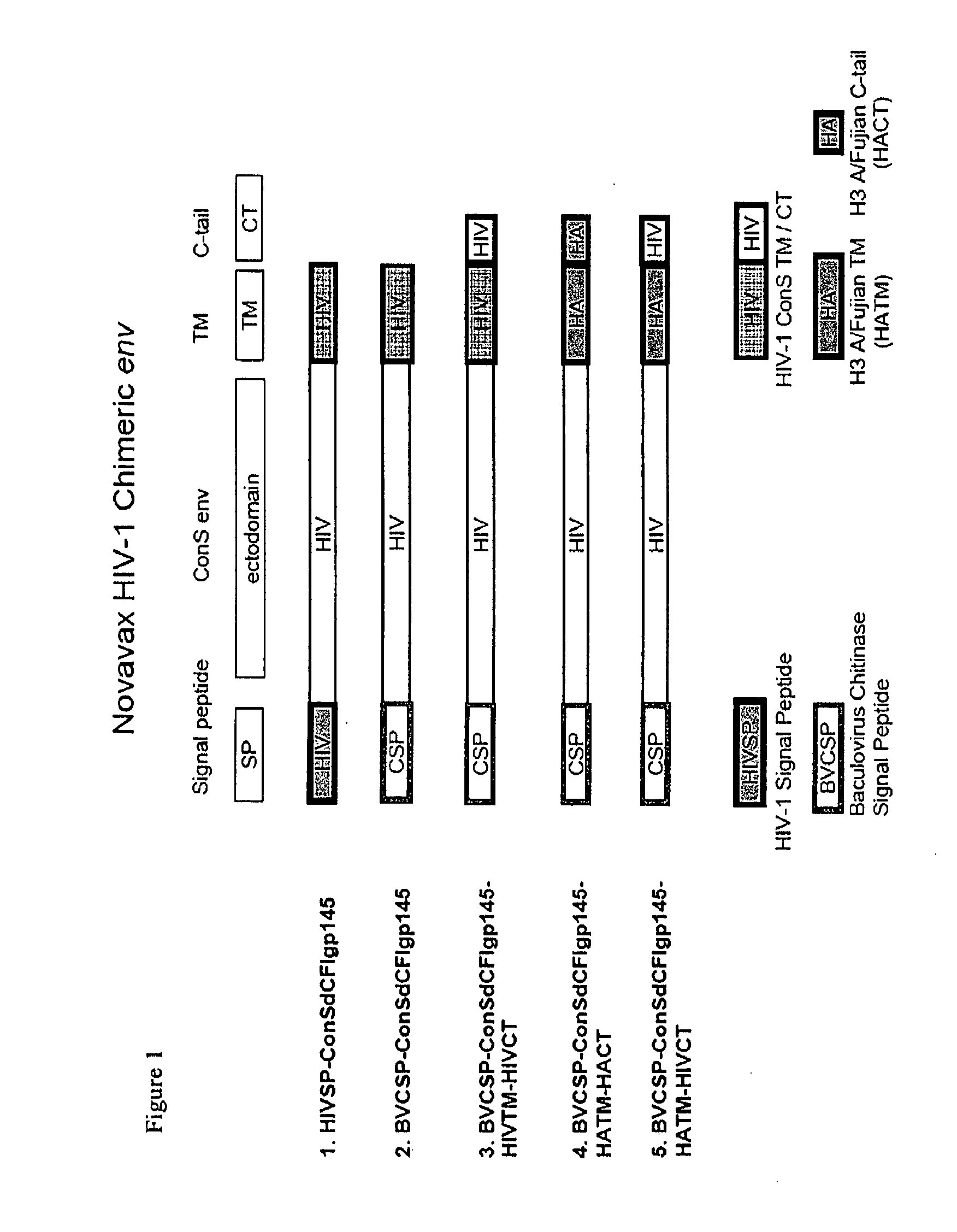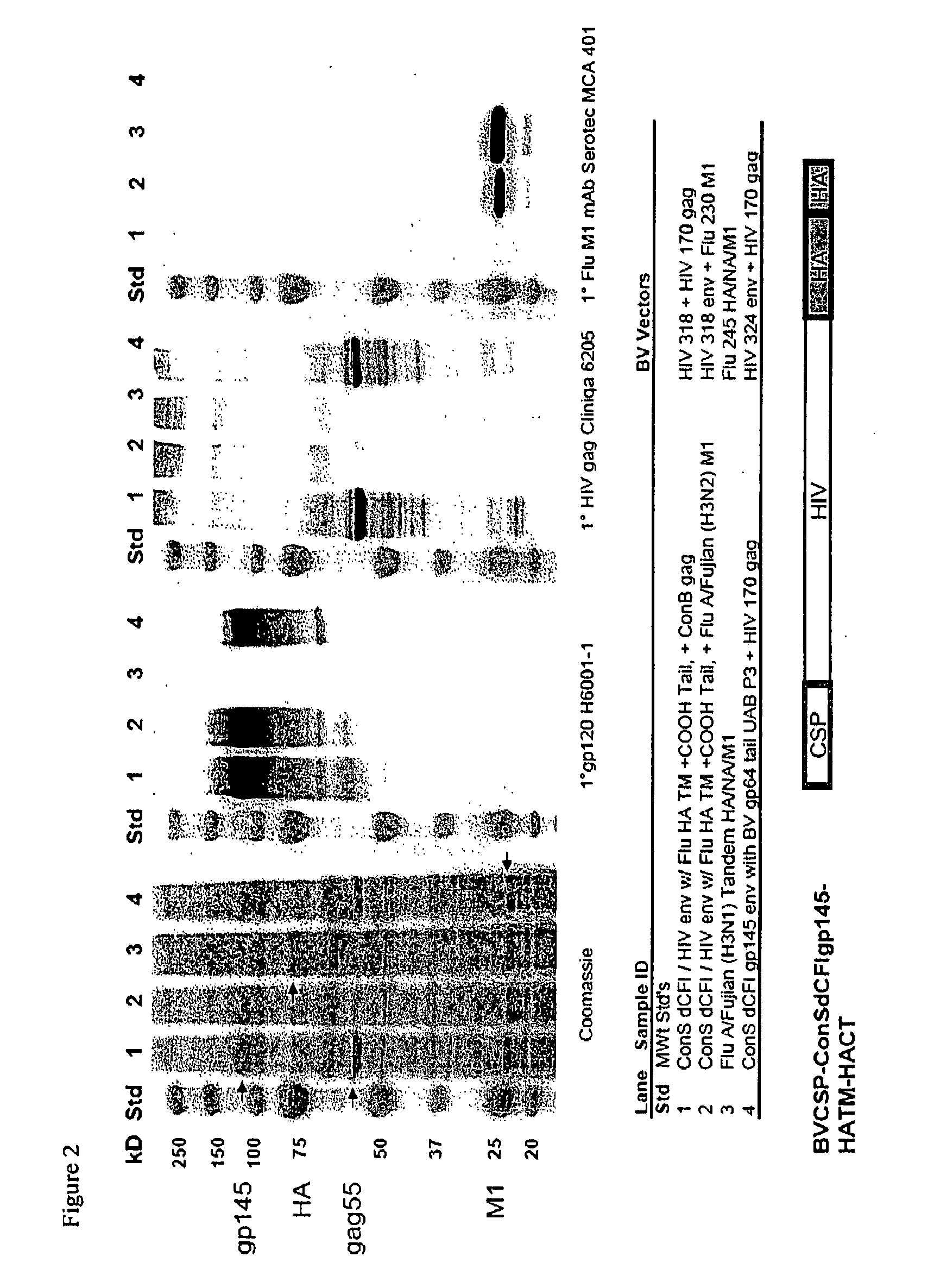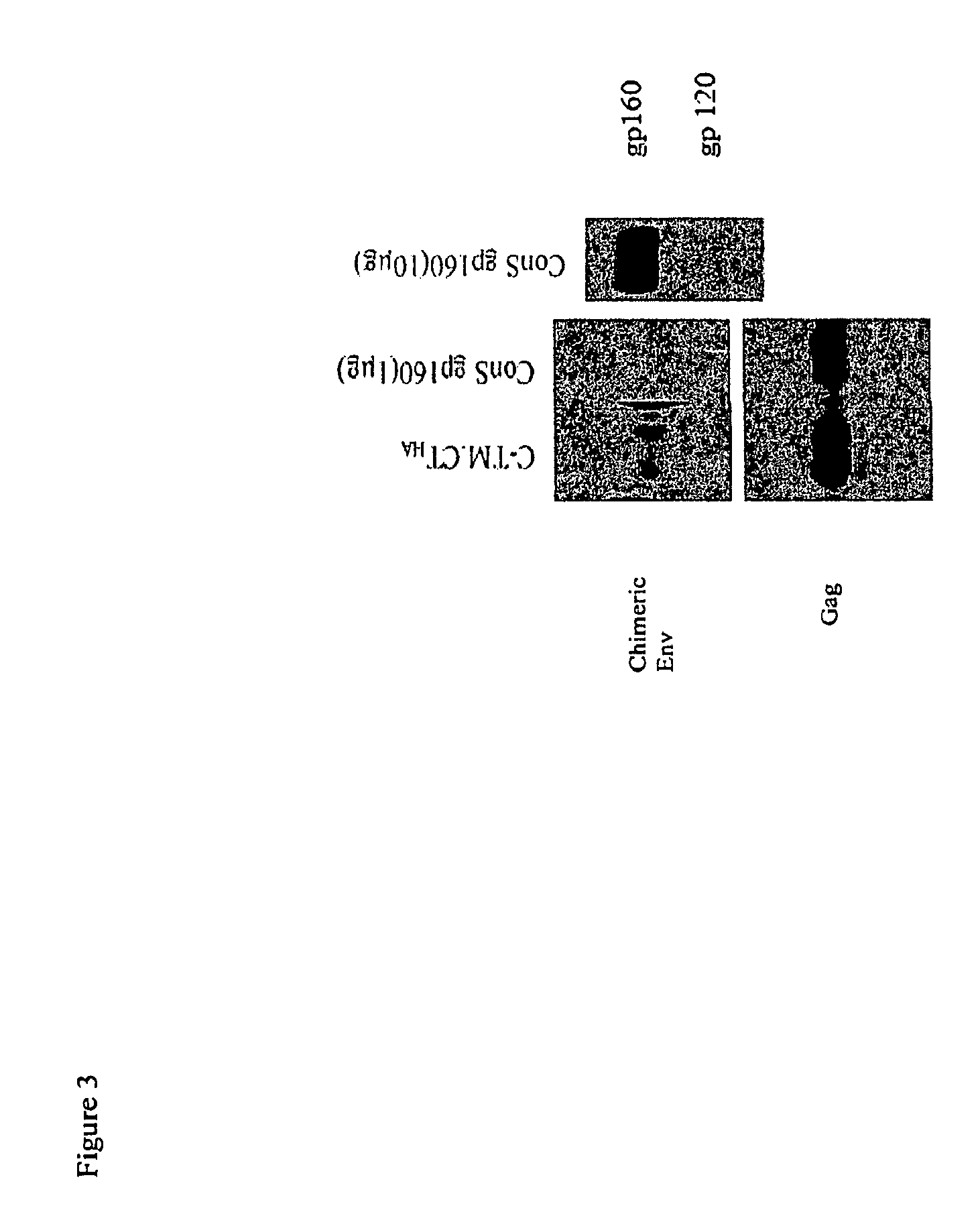Methods of enhancing protein incorporation into virus like particles
a technology of like particles and protein, applied in the field of enhancing protein incorporation into like particles of viruses, can solve the problem that complex viruses such as hiv-1 and influenza cannot be assembled in vitro from individual components, and achieve the effect of increasing glycoprotein incorporation
- Summary
- Abstract
- Description
- Claims
- Application Information
AI Technical Summary
Benefits of technology
Problems solved by technology
Method used
Image
Examples
example 1
[0089]Construction of chimeric Con-S Env gene. The Con-S ΔCFI gp145 gene, a derivative of the consensus HIV-1 group M ConS env gene which lacks the 120-gp41 cleavage (C) site, the fusion (F) peptide, an immunodominant (I) region in gp41, as well as the CT domain (Liao, H. X., et al. (2006) Virology 353, 268-282). PCR was used to make all the constructs. The PCR products were cloned into vector pBluescript II KS (pBlue) in the polylinker site with BamHI and SalI, and the resulting construct was used to generate chimeric HIV-1 Env mutants.
[0090]To construct an influenza HA derived chimeric Con-S ΔCFI Env gene, the HIV-1 signal peptide was replaced with chitinase SP derived from Autographa californica Nuclear Polyhedrosis Virus (AcNPV) chitinase gene. The TM and CT domains of Con-S were replaced with the corresponding C-terminal region of influenza HA that contained putative transmembrane and carboxy terminal sequences derived from influenza A / Fujian / 411 / 02 (H3N2) hemagglutinin. The ch...
example 2
[0095]Design of chimeric Env proteins. The following gp145 sequences and derivatives from HIV-1 were cloned into the pFastBac1 (InVitrogen), resulting pFastBac1-based plasmids expressing of HIV gp145 glycoproteins and chimeric constructs.
gp45SEQ ID NO. 1 -Wild typeSignal peptide shown in bold, HIV Transmembrane underlinedMRVRGIQRNCQHLWRWGTLILGMLMICSAAENLWVTVYYGVPVWKEANTTLFCASDAKAYDTEVHNVWATHACVPTDPNPQEIVLENVTENFNMWKNNMVEQMHEDIISLWDQSLKPCVKLTPLCVTLNCTNVNVTNTTNNTEEKGEIKNCSFNITTEIRDKKQKVYALFYRLDVVPIDDNNNNSSNYRLINCNTSAITQACPKVSFEPIPIHYCAPAGFAILKCNDKKFNGTGPCKNVSTVQCTHGIKPVVSTQLLLNGSLAEEEIIIRSENITNNAKTIIVQLNESVEINCTRPNNNTRKSIRIGPGQAFYATGDIIGDIRQAHCNISGTKWNKTLQQVAKKLREHFNNKTIIFKPSSGGDLEITTHSFNCRGEFFYCNTSGLFNSTWIGNGTKNNNNTNDTITLPCRIKQIINMWQGVGQAMYAPPIEGKITCKSNITGLLLTRDGGNNNTNETEIFRPGGGDMRDNWRSELYKYKVVKIEPLGVAPTKAKLTVQARQLLSGIVQQQSNLLRAIEAQQHLLQLTVWGIKQLQARVLAVERYLKDQQLLEIWDNMTWMEWEREINNYTDIIYSLIEESQNQQEKNEQELLALDKWASLWNWFDITNWLWYIKIFIMIV GGLIGLRIVFAVLSISEQ ID NO 2Chitinase signal peptide ...
example 3
[0096]Following production of recombinant baculovirus, Spodoptera frugiperda cells (Sf9) were infected with one or a mixture of recombinant baculovirus (listed on FIG. 1), infected cells were removed by low speed centrifugation from the culture media at about 72 hours post infection. VLP particles recovered from the media using centrifugation at 100,000×g for 1 hour. The VLPs were analyzed (FIG. 2) using SDS-PAGE (left panel) and western blot with anti HIV-1 gp120 (second panel), anti HIV-1 p55 core (third panel), and anti-influenza M1 core (right panel). Lanes 1 and 2 are the HIV-1 env with an influenza transmembrane and C-terminus secreted from Sf9 cells particles when co-expressed with the HIV-1 capsid (p55 core; lane 1) or influenza capsid (M1 matrix; lane 2). Lane 3 is the VLPs with full length influenza A / Fujian HA and M co-expressed in Sf9 cells; the arrow points to recombinant hemagglutinin. Lane 4 is another modified HIV-1 envelope which comprises the transmembrane region a...
PUM
| Property | Measurement | Unit |
|---|---|---|
| Composition | aaaaa | aaaaa |
Abstract
Description
Claims
Application Information
 Login to View More
Login to View More - R&D Engineer
- R&D Manager
- IP Professional
- Industry Leading Data Capabilities
- Powerful AI technology
- Patent DNA Extraction
Browse by: Latest US Patents, China's latest patents, Technical Efficacy Thesaurus, Application Domain, Technology Topic, Popular Technical Reports.
© 2024 PatSnap. All rights reserved.Legal|Privacy policy|Modern Slavery Act Transparency Statement|Sitemap|About US| Contact US: help@patsnap.com










